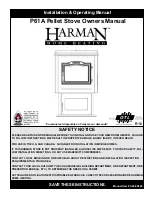
4. Check all joints of gas supply
piping system. Apply mixture of
liquid soap and water to gas
joints. Bubbles forming show a
leak.
5. Correct all leaks at once.
6. Reconnect
heater and equipment
shutoff valve to gas supply.
Check reconnected fittings for
leaks.
Test Pressures Equal To or Less
Than 1/2 psi (3.5 kPa)
1. Close equipment shutoff valve
(See Figure 19).
2. Pressurize supply piping system
by either using compressed air or
opening main gas valve located
on or near gas meter.
3. Check all joints from gas meter
to equipment shutoff valve (See
Figure 20). Apply mixture of
liquid soap and water to gas
joints. Bubbles forming show a
leak.
4. Correct all leaks at once.
Pressure Testing Heater Gas
Connections
1. Open equipment shutoff valve (See
Figure 19).
2. Open main gas valve located on or
near gas meter.
3. Make sure control knob of heater is in
the OFF position.
4. Check all joints from equipment
shutoff valve to control valve (See
Figure 20). Apply mixture of liquid
soap and water to gas joints. Bubbles
forming show a leak.
5. Correct all leaks at once.
6. Light
heater
(See
Operating Heater,
pages 17 through 19). Check all other
internal joints for leaks.
7. Turn off heater (See
To Turn Off Gas
to Appliance on pages 17 through
19).
Input Minimum Maximum
Rating 22,400 32,000
Type of Gas LP/Propane Natural
Manifold
Pressure 10.0
"
wc 3.5
"
wc
*Min. Inlet 10.5
"
wc 4.5
"
wc
Max. Inlet 13.0
"
wc 10.5
"
wc
*For purpose of input adjustment.
The appliance must be isolated from the gas
supply piping system by closing its equipment
shutoff valve during any pressure testing of the
gas supply piping system at test pressures equal
to or less than ½ psi (3.5 kPa).
INSTALLATION
Continued
We recommend that you install a
sediment trap in supply line. Locate
sediment trap where it is within reach
for cleaning. Install in piping system
between fuel supply and heater. Locate
sediment trap where trapped matter is
not likely to freeze. A sediment trap
traps moisture and contaminants. This
keeps them from going into heater
controls. If sediment trap is not
installed or is installed wrong, heater
may not run properly.
CAUTION:
Avoid damage to
regulator. Hold gas regulator
with wrench when connecting it
to gas piping and/or fittings.
CHECKING GAS
CONNECTIONS
WARNING:
Test all gas piping
and connections for leaks after
installing or servicing. Correct all
leaks at once.
WARNING:
Never use an open
flame to check for a leak. Apply a
mixture of liquid soap and water
to all joints. Bubbles forming
show a leak. Correct all leaks at
once.
Pressure Testing Gas Supply
Piping System
Test Pressures In Excess of 1/2 psi
(3.5 kPa)
1. Disconnect appliance with its
appliance main gas valve (control
valve) and equipment shutoff valve
from gas supply piping system.
Pressures in excess of 1/2 psi will
damage heater regulator.
2. Cap off open end of gas pipe
where equipment shutoff valve
was connected.
3. Pressurize supply piping system by
either using compressed air or
opening main gas valve located on
or near gas meter.
OPEN
CLOSED
EQUIPMENT
SHUTOFF
VALVE
FIGURE 19
- EQUIPMENT SHUTOFF
VALVE
CONTROL VALVE LOCATION
EQUIPMENT
SHUTOFF
VALVE
GAS METER
FIGURE 20
- CHECKING GAS JOINTS
15
Содержание GAS STOVE HEATER
Страница 2: ......
Страница 29: ...1 2 4 5 6 7 10 9 FIGURE 27 PARTS 25...
Страница 30: ...8 8A 3 FIGURE 28 VALVES AND SUPPLY LINES 26...
Страница 34: ...PARTS BREAKDOWN FOR CAST STOVE SERIES HEPPLEWHITE 30...
















































